Understanding the Implementation Challenges of Urban Resilience Policies: Investigating the Influence of Urban Geological Risk in Thessaloniki, Greece
Abstract
:1. Introduction
2. Materials and Methods
2.1. Methodological Approach
- location, footprint and use of buildings, roads and infrastructure as per the official datasets available from the city data portal, Open Street Maps and Copernicus Land Monitoring Service Urban Atlas;
- thickness and distribution of the anthropogenic deposits published in the specialist literature, particularly by Makedon et al. [16] (but others as well), which was also our main reference for the spatial classification of buildings in the city centre by building code, damage mapped after the major earthquake event occurred in 1978 and thickness of the underlying deposits;
- location and extent of new urban development as evidenced by analysing the time series of high-resolution satellite optical imagery (2003–2017) available in Google Earth and Bing Maps.
- the geohazards recognised by the Municipality as key sources of shocks for the city;
- the indication of the components of the city urban environment and land use that raise major concerns for their potential role (either beneficial or detrimental) on management during emergencies and towards risk reduction;
- the aspiration of the city, its vision and planned actions to achieve the goal of reducing risk.
2.2. Presentation of the Case Study
2.2.1. Thessaloniki’s PRA and RS
2.2.2. Seismic Susceptibility
2.2.3. Surface/Groundwater Flooding
3. Results
3.1. The Acheiropoietos Electoral Ward Case Study
3.1.1. Geological Vulnerability
3.1.2. Exposure of the Built Environment
3.1.3. Earthquakes in Thessaloniki’s RS
- A general understanding that the municipality should not be responsible for accounting for geological risk, as other institutions, such as the Decentralised Administration of Macedonia and Thrace or the Institute of Geology and Mineral Exploration, are more appropriate for this task.
- The environment of the historic centre of the city is a retrofit environment and was perceived as having very little degree of adaptive opportunities, and thus technical measures were not explored further.
- The fact that responsibility for policy, such as building codes, does not sit in the municipality.
- Earthquake management was not categorized as a top-priority area for the design of the RS.
3.2. The Thermaikos Municipality Case Study
3.2.1. Geological Vulnerability
3.2.2. Exposure of the Built Environment
3.2.3. Surface Flooding in Thessaloniki’s RS
4. Discussion
4.1. Lack of Geological Insight in the Design of Resilience Strategies
4.2. Relationship between the Built Environment and Emergency Planning
4.3. Horizontal Communication among the Geologically Related Organizations
4.4. Lessons Learned
5. Conclusions
Author Contributions
Funding
Acknowledgments
Conflicts of Interest
Appendix A
| Dataset | Source | Year |
|---|---|---|
| Administrative boundaries | Thessaloniki GIS portal (https://gis.thessaloniki.gr/) | 2018 |
| Geological Map of Greece—Thessaloniki Sheet (scale 1:50,000) | Institute of Geological and Mining Research of Greece | 1978 |
| Engineering Geology Map of the Thessaloniki Wider Area (scale 1:50,000) | Institute of Geology and Mineral Exploration (IGME) | 2000 |
| Earthquakes over 4.0 Richter Magnitude | National Observatory of Greece, Institute of Geodynamics (http://www.gein.noa.gr/en/seismicity/earthquake-catalogs) | 2017 |
| Database of high-impact weather events in Greece (2001–2012) | National Observatory of Athens (NOA), Papagiannaki et al. [30] | 2013 |
| Floods in Greece (1880–2010) | Diakakis et al. [29] | 2012 |
| On-Line Flood Database for Greece | Nikolaidou et al. [31] ceogis-floods.web.auth.gr | 2014 |
| Building uses in Thessaloniki Metropolitan Area | Thessaloniki GIS portal (https://gis.thessaloniki.gr/) | 2018 |
| Building geometry (from Open Street Maps) | Open Street Maps (https://www.openstreetmap.org/) | 2018 |
| Geotectonical zones of Northern Greece | Makedon et al. [16] | 2009 |
| Urban fill thickness | Makedon et al. [16] | 2009 |
| Land cover map | Copernicus Land Monitoring Service, Urban Atlas (https://land.copernicus.eu/) | 2006 |
| High-resolution satellite optical imagery (2003–2017) | Google Earth, Bingmap | 2017 |
| Digital Elevation Model (DEM) | USGS (https://earthexplorer.usgs.gov/) | 2000 |
| Hydrology | http://data.gov.gr/, and digitised based on Google Earth and DEM | 2018 |
References
- Welsh, M. Resilience and responsibility: Governing uncertainty in a complex world. Geogr. J. 2014, 180, 15–26. [Google Scholar] [CrossRef]
- Alexander, D.E. Resilience and disaster risk reduction: An etymological journey. Nat. Hazards Earth Syst. Sci. 2013, 13, 2707–2716. [Google Scholar] [CrossRef]
- Meerow, S.; Newell, J.P.; Stults, M. Defining urban resilience: A review. Landsc. Urban Plan. 2016, 147, 38–49. [Google Scholar] [CrossRef]
- Coaffee, J.; Clarke, J. On securing the generational challenge of urban resilience. Town Plan. Rev. 2015, 28, 323–339. [Google Scholar] [CrossRef]
- United Nations General Assembly. Report of the Open-Ended Intergovernmental Expert Working Group on Indicators and Terminology relating to Disaster Risk Reduction; United Nations General Assembly: New York, NY, USA, 2017. [Google Scholar]
- Davoudi, S. Resilience: A Bridging Concept or a Dead End? Plan. Theory Pract. 2012, 13, 299–307. [Google Scholar] [CrossRef]
- Rockefeller Foundation 100 Resilient Cities. Available online: http://www.100resilientcities.org/ (accessed on 7 October 2018).
- Da Silva, J.; Moench, M. City Resilience Framework. Arup 2014. Available online: http://www.seachangecop.org/files/documents/URF_Bo (accessed on 7 October 2018).
- Bourgon, J. New directions in public administration: Serving beyond the predictable. Public Policy Adm. 2009, 24, 309–330. [Google Scholar] [CrossRef]
- Matyas, D.; Pelling, M. Positioning resilience for 2015: The role of resistance, incremental adjustment and transformation in disaster risk management policy. Disasters 2015, 39, s1–s18. [Google Scholar] [CrossRef] [PubMed]
- Boin, A.; van Eeten, M.J.G. The Resilient Organization. Public Manag. Rev. 2013, 15, 429–445. [Google Scholar] [CrossRef]
- Taleb, N.N. The Black Swan: The Impact of the Highly Improbable; Penguin Books Ltd.: London, UK, 2007; ISBN 1400063515 9781400063512 9780713999952. [Google Scholar]
- Thessaloniki Resilience Team. Thessaloniki: Preliminary Resilience Assessment; Municipality of Thessaloniki: Thessaloniki, Greece; Metropolitan Developmental Agency of Thessaloniki S.A.: Thessaloniki, Greece, 2016. [Google Scholar]
- Thessaloniki Resilience Team. Resilient Thessaloniki: A Strategy for 2030; Municipality of Thessaloniki: Thessaloniki, Greece; Metropolitan Developmental Agency of Thessaloniki S.A.: Thessaloniki, Greece, 2017. [Google Scholar]
- Crowe, P.R.; Foley, K.; Collier, M.J. Operationalizing urban resilience through a framework for adaptive co-management and design: Five experiments in urban planning practice and policy. Environ. Sci. Policy 2016, 62, 112–119. [Google Scholar] [CrossRef]
- Makedon, T.; Chatzigogos, N.P.; Spandos, S. Engineering geological parameters affecting the response of Thessaloniki’s urban fill to a major seismic event. Eng. Geol. 2009, 104, 167–180. [Google Scholar] [CrossRef]
- Berkes, F.; Ross, H. Community Resilience. Toward an Integrated Approach. Soc. Nat. Resour. 2013, 26, 5–20. [Google Scholar] [CrossRef]
- Galderisi, A.; Ferrara, F.F. Enhancing Urban Resilience in Face of Climate Change. TEMA J. L. Use Mobil. Environ. 2012, 5, 69–88. [Google Scholar] [CrossRef]
- Manos, G. Greece. In International Handbook of Earthquake Engineering; Paz, M., Ed.; Springer: Boston, MA, USA, 1994; ISBN 978-1-4613-5859-6. [Google Scholar]
- Vayona, A. Investigating the preferences of individuals in redeveloping waterfronts: The case of the port of Thessaloniki - Greece. Cities 2011, 28, 424–432. [Google Scholar] [CrossRef]
- Raspini, F.; Loupasakis, C.; Rozos, D.; Adam, N.; Moretti, S. Ground subsidence phenomena in the Delta municipality region (Northern Greece): Geotechnical modeling and validation with Persistent Scatterer Interferometry. Int. J. Appl. Earth Obs. Geoinf. 2014, 28, 78–89. [Google Scholar] [CrossRef] [Green Version]
- Charles, J.A.; Watts, K.S. Building on Fill: Geotechnical Aspects; IHS: Bracknell, Berkshire, UK, 2015; ISBN 9781906846220. [Google Scholar]
- Raspini, F.; Loupasakis, C.; Rozos, D.; Moretti, S. Advanced interpretation of land subsidence by validating multi-interferometric SAR data: The case study of the Anthemountas basin (Northern Greece). Nat. Hazards Earth Syst. Sci. 2013, 13, 2425–2440. [Google Scholar] [CrossRef] [Green Version]
- Pitilakis, K.; Anastasiadis, A.; Kakderi, K.; Argyroudis, S.A.; Alexoudi, M. Vulnerability Assessment and Risk Management of Lifelines, Infrastructures and Critical Facilities. The Case of Thessaloniki’s Metropolitan Area. In Proceedings of the 4th International Conference on Earthquake Geotechnical Engineering, Thessaloniki, Greece, 25–28 June 2007; pp. 1–15. [Google Scholar]
- Penelis, G.G.; Sarigiannis, D.; Stavrakakis, E.; Stylianidis, K.C. A statistical evaluation of damage to buildings in the Thessaloniki, Greece, earthquake of June, 20, 1978. In Proceedings of the 9th World Conference on Earthquake Engineering, Tokyo, Japan, 2–19 August 1989; pp. 187–192. Available online: http://www.iitk.ac.in/nicee/wcee/article/9_vol7_187.pdf (accessed on 7 October 2018).
- Kappos, A.J.; Panagopoulos, G.; Penelis, G.G. Development of a seismic damage and loss scenario for contemporary and historical buildings in Thessaloniki, Greece. Soil Dyn. Earthq. Eng. 2008, 28, 836–850. [Google Scholar] [CrossRef]
- Riga, E.; Karatzetzou, A.; Mara, A.; Pitilakis, K. Studying the uncertainties in the seismic risk assessment at urban scale applying the Capacity Spectrum Method: The case of Thessaloniki. Soil Dyn. Earthq. Eng. 2017, 92, 9–24. [Google Scholar] [CrossRef]
- Gospodini, A. Economic Crisis and the Shrinking Greek Cities. In Proceedings of the 1st International Conference on Architecture & Urban Design, Tirana, Albania, 19–21 April 2012; pp. 685–702. [Google Scholar]
- Diakakis, M.; Mavroulis, S.; Deligiannakis, G. Floods in Greece, a statistical and spatial approach. Nat. Hazards 2012, 485–500. [Google Scholar] [CrossRef]
- Papagiannaki, K.; Lagouvardos, K.; Kotroni, V. A database of high-impact weather events in Greece: A descriptive Atmospheric impact analysis for the period 2001–2011. Nat. Hazards Earth Syst. Sci. 2013, 13, 727–736. [Google Scholar] [CrossRef]
- Nikolaidou, M.; Mouratidis, A.; Doxani, G.; Oikonomidis, D.; Tsakiri-Strati, M.; Sart, F. An on-line flood Database for Greece supported by Earth Observation Data and GIS. In 10th International Geographical Congress of Hellenic Geographical Society; Hellenic Geographical Society: Thessaloniki, Greece, 2014; pp. 662–670. [Google Scholar]
- Cao, C.; Xu, P.; Wang, Y.; Chen, J.; Zheng, L.; Niu, C. Flash flood hazard susceptibility mapping using frequency ratio and statistical index methods in coalmine subsidence areas. Sustainability 2016, 8, 948. [Google Scholar] [CrossRef]
- Gaume, E.; Bain, V.; Bernardara, P.; Newinger, O.; Barbuc, M.; Bateman, A.; Blaskovicova, L.; Bloschl, G.; Borga, M.; Dumitrescu, A.; et al. A compilation of data on European flash floods. J. Hydrol. 2009, 367, 70–78. [Google Scholar] [CrossRef] [Green Version]
- Anastasiadis, A.; Raptakis, D.; Pitilakis, K. Thessaloniki’s detailed microzoning: Subsurface structure as basis for site response analysis. Pure Appl. Geophys. 2001, 158, 2597–2633. [Google Scholar] [CrossRef]
- Papadopoulou, I.; Tziavos, I.N.; Savvaidis, P. Remote Sensing and Geographic Information Systems (GIS) Contribution to the Inventory of Infrastructure Susceptible to Earthquake and Flooding Hazards in North-Eastern Greece. Geosciences 2012, 2, 203–220. [Google Scholar] [CrossRef] [Green Version]
- Verani, E.; Pozoukidou, G.; Sdoukopoulos, A. The effect of urban density, green spaces and mobility patterns in cities’ environmental quality: An empirical study of the metropolitan area of Thessaloniki. Spatium 2015, 1, 8–17. [Google Scholar] [CrossRef]
- Yamamoto, K.; Li, X. Safety Evaluation of Evacuation Routes in Central Tokyo Assuming a Large-Scale Evacuation in Case of Earthquake Disasters. Risk Financ. Manag. 2017, 10, 14. [Google Scholar] [CrossRef]
- BBC News. Greece Flash Floods Leave At Least Three Dead. Available online: http://www.bbc.co.uk/news/world-europe-37295180 (accessed on 7 September 2016).
- Raspini, F.; Bianchini, S.; Moretti, S.; Loupasakis, C.; Rozos, D.; Duro, J.; Garcia, M. Advanced interpretation of interferometric SAR data to detect, monitor and model ground subsidence: outcomes from the ESA-GMES Terrafirma project. Nat. Hazards 2016, 83, 155–181. [Google Scholar] [CrossRef]
- Watchers Heavy Rain, Hail and Floods Hit Thessaloniki, Greece. Available online: https://watchers.news/2018/05/11/heavy-rain-hail-and-floods-hit-thessaloniki-greece/. (accessed on 7 October 2018).
- Duit, A. Resilience Thinking: Lessons for Public Administration. Public Adm. 2016, 94, 364–380. [Google Scholar] [CrossRef]
- Bricker, S.; Reeves, H.; Campbell, S.D.G.; Price, S. The Ground Beneath Cities: Where Should Future Development Occur? 2012. Available online: https://assets.publishing.service.gov.uk/government/uploads/system/uploads/attachment_data/file/461947/future-cities-ground-beneath.pdf (accessed on 7 October 2018).
- Tapete, D. Book Review: Reconnecting the City, Bandarin, Francesco & van Oers, Ron (eds.), John Wiley & Sons, Ltd., Oxford, UK, 2014, (344 pp.). Cities 2016, 56, 99–100. [Google Scholar] [CrossRef]
- Coaffee, J.; Therrien, M.-C.; Chelleri, L.; Henstra, D.; Aldrich, D.; Mitchell, C.; Tsenkova, S.; Rigaud, E. Urban resilience implementation: A policy challenge and research agenda for the 21st century. J. Contingencies Cris. Manag. 2018, 26, 403–410. [Google Scholar] [CrossRef]
- Lu, P.; Stead, D. Understanding the notion of resilience in spatial planning: A case study of Rotterdam, The Netherlands. Cities 2013, 35, 200–212. [Google Scholar] [CrossRef]
- Adger, N. Social and ecological resilience: Are they related? Prog. Hum. Geogr. 2000, 3, 347–364. [Google Scholar] [CrossRef]
- Brown, K. Global environmental change I: A social turn for resilience? Prog. Hum. Geogr. 2014, 38, 107–117. [Google Scholar] [CrossRef] [Green Version]
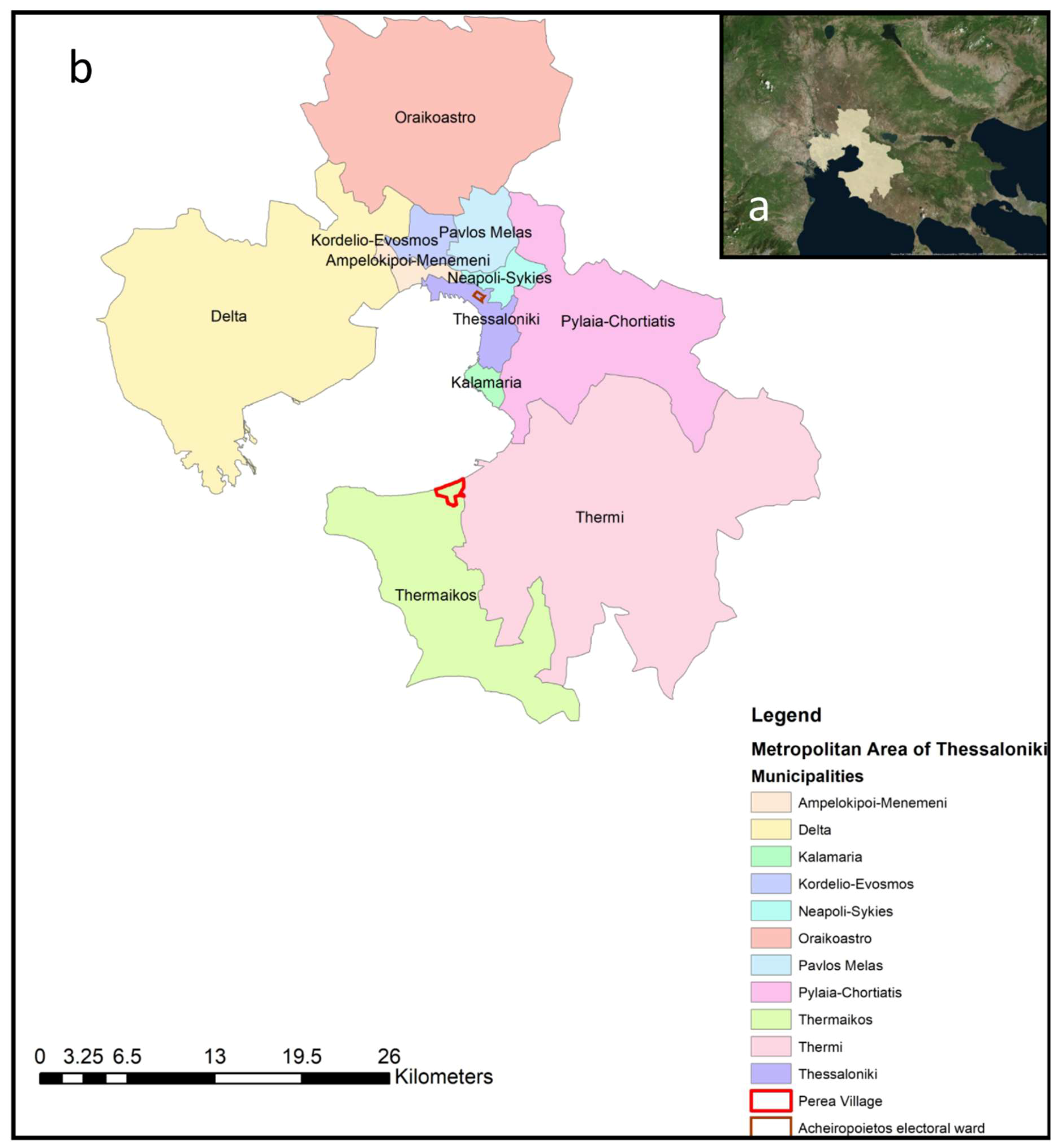
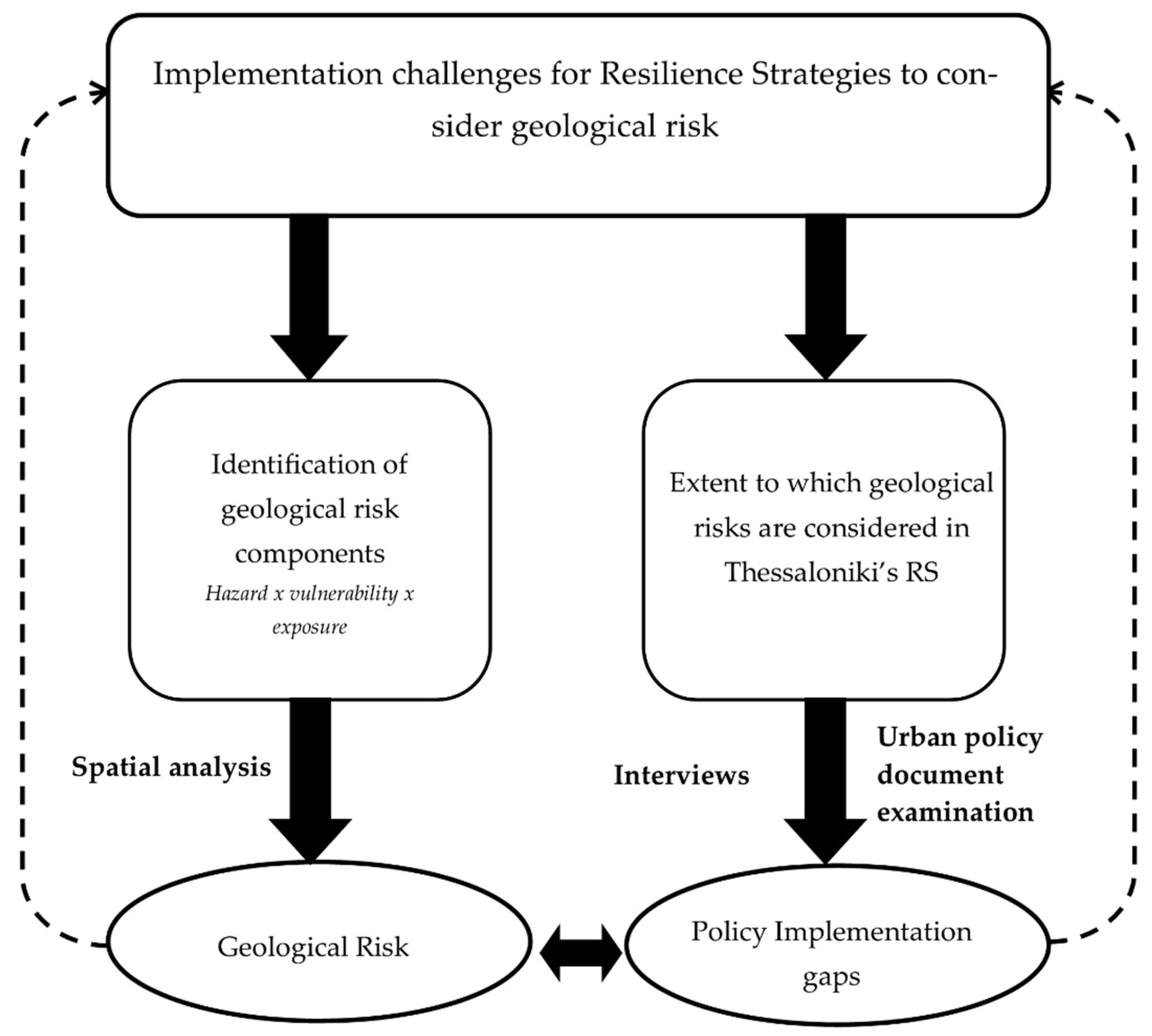


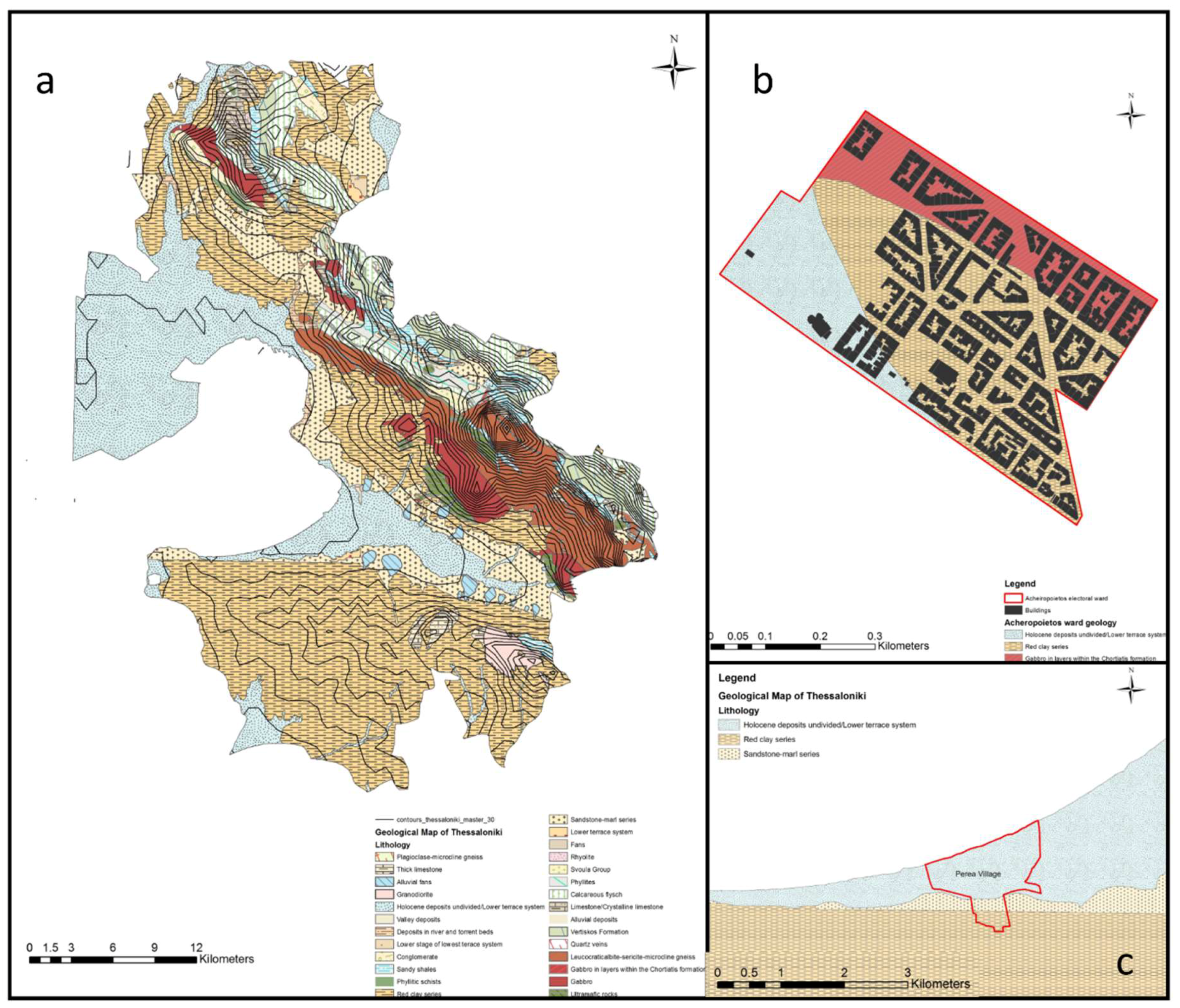
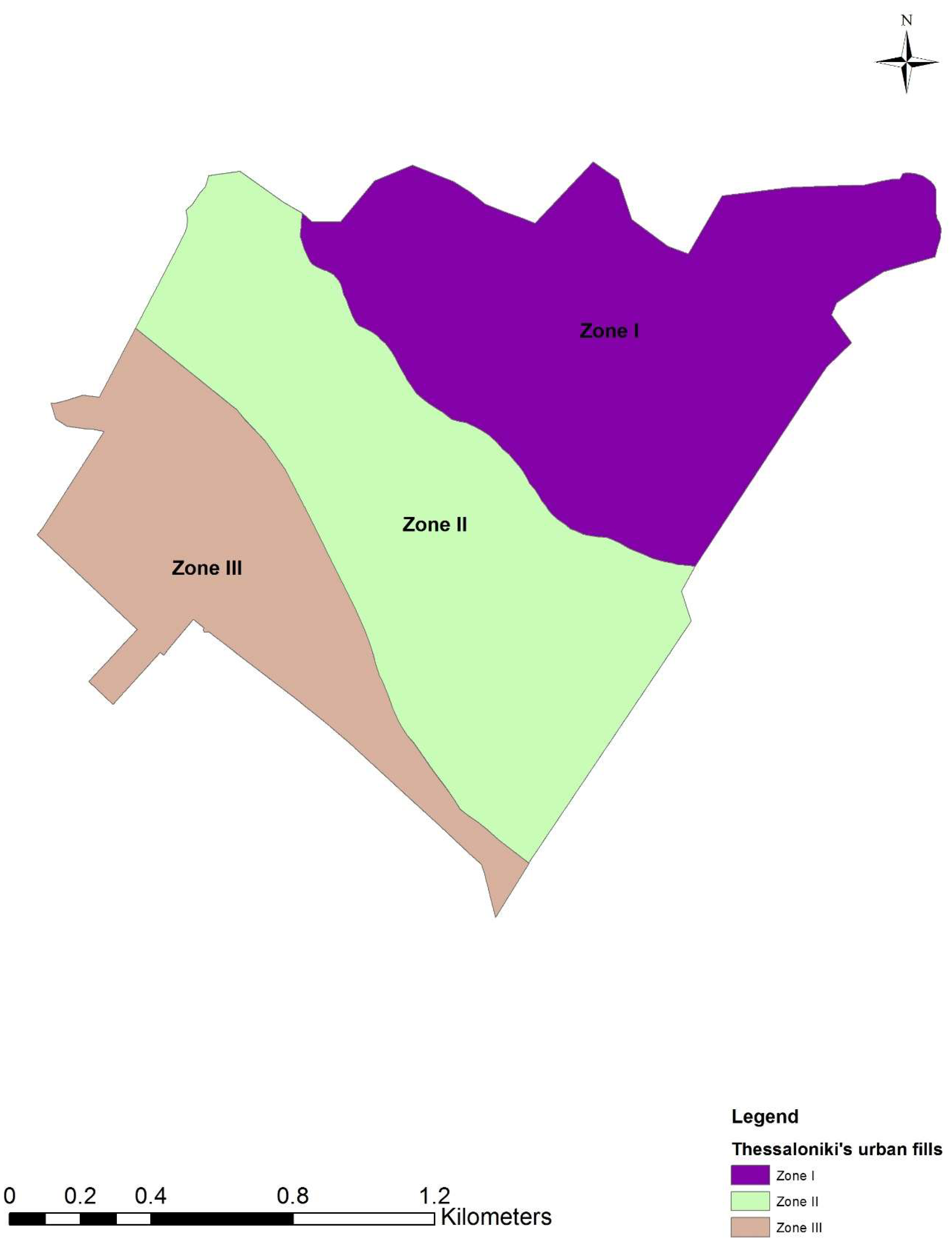

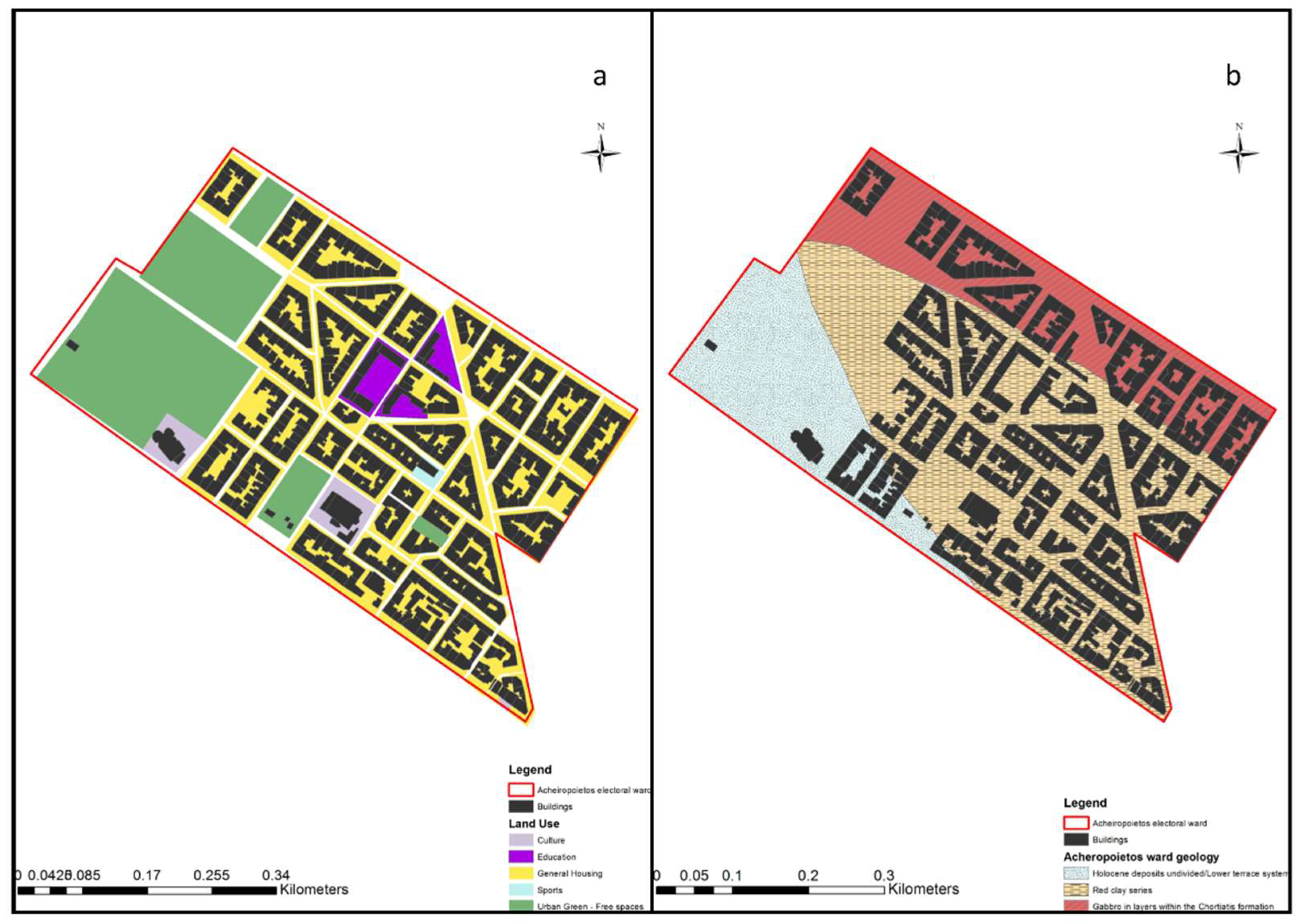

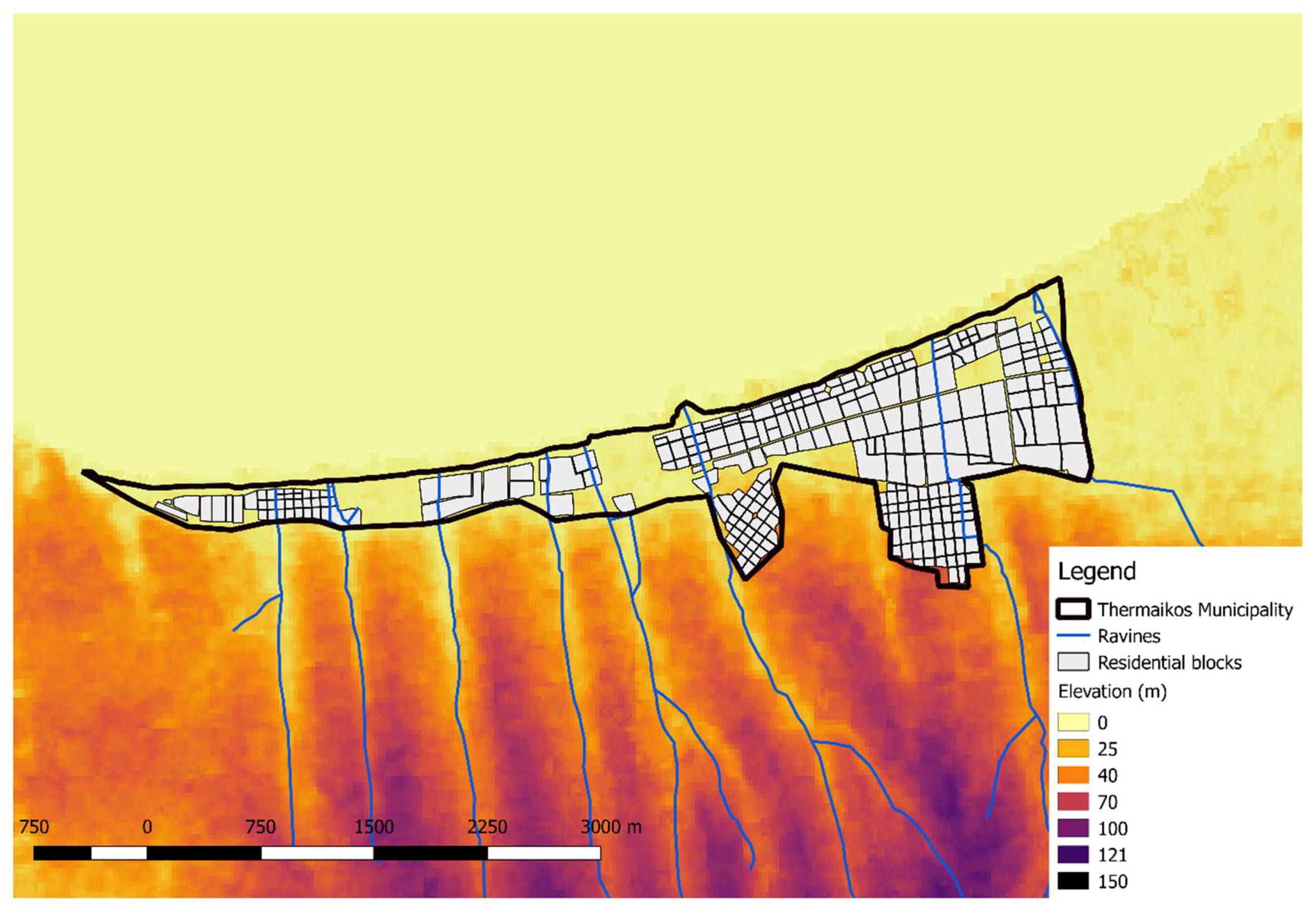
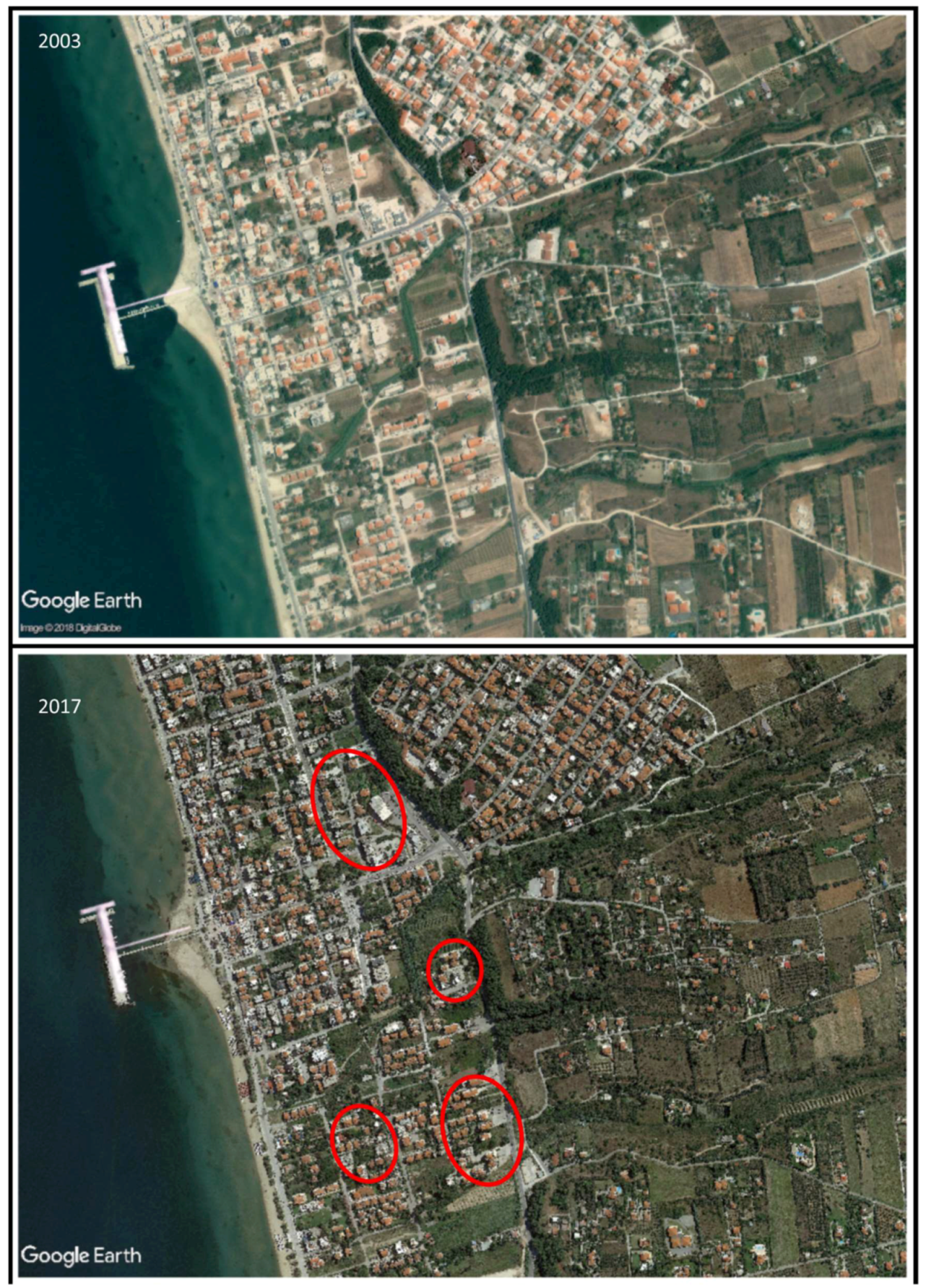
| Building Block | Number of Floors (Mean) | Building Density (FAR) | Building Height (Mean) (m) | Area (m2) | Mean Distance from Free Space (m) | Minimum Distance from Free Space (m) |
|---|---|---|---|---|---|---|
| 725 | 5.50 | 3.08 | 15.40 | 4157.27 | 229.03 | 51.98 |
| 755 | 6.45 | 3.72 | 18.06 | 4267.51 | 223.39 | 52.36 |
| 772 | 5.59 | 3.07 | 15.65 | 7436.36 | 260.04 | 127.44 |
| 807 | 6.38 | 4.04 | 17.86 | 4226.22 | 272.35 | 183.40 |
| 808 | 5.82 | 3.38 | 16.30 | 4144.63 | 199.22 | 120.05 |
| 816 | 6.67 | 3.44 | 18.68 | 3704.44 | 317.25 | 247.30 |
| 822 | 5.43 | 3.10 | 15.20 | 6474.97 | 238.77 | 191.95 |
| 826 | 6.00 | 2.78 | 16.80 | 2799.39 | 380.67 | 310.23 |
| 832 | 4.19 | 2.27 | 11.73 | 5616.51 | 194.60 | 147.41 |
| 835 | 6.27 | 3.82 | 17.56 | 5908.81 | 414.50 | 313.56 |
| 858 | 4.50 | 2.62 | 12.60 | 2129.89 | 472.53 | 362.05 |
| 862 | 7.14 | 3.32 | 19.99 | 3554.42 | 347.24 | 228.20 |
| 866 | 6.12 | 3.98 | 17.14 | 6200.24 | 508.38 | 370.42 |
| 867 | 3.60 | 1.32 | 10.08 | 4272.53 | 193.33 | 127.04 |
| 870 | 5.09 | 3.33 | 14.25 | 2288.76 | 449.53 | 316.06 |
| 878 | 5.69 | 3.66 | 15.93 | 4021.97 | 221.81 | 86.59 |
| 879 | 6.25 | 3.17 | 17.50 | 5584.88 | 560.68 | 410.32 |
| 886 | 7.17 | 4.18 | 20.08 | 2649.88 | 431.18 | 271.32 |
| 889 | 6.83 | 4.29 | 19.12 | 2767.56 | 256.89 | 82.19 |
| 891 | 6.25 | 4.01 | 17.50 | 3922.29 | 364.38 | 203.68 |
| 892 | 6.50 | 4.37 | 18.20 | 2542.18 | 318.44 | 145.54 |
| 897 | 6.36 | 3.81 | 17.81 | 4715.72 | 216.32 | 110.05 |
| 904 | 6.64 | 4.12 | 18.59 | 5166.53 | 478.42 | 300.28 |
| 906 | 6.64 | 4.00 | 18.59 | 3789.76 | 308.07 | 103.82 |
| 908 | 6.69 | 4.19 | 18.73 | 4486.10 | 238.70 | 57.32 |
| 911 | 6.63 | 3.39 | 18.56 | 4130.45 | 422.39 | 229.71 |
| 917 | 5.40 | 2.00 | 15.12 | 2548.11 | 536.24 | 355.72 |
| 924 | 6.50 | 4.05 | 18.20 | 1454.69 | 364.04 | 155.29 |
| 933 | 6.40 | 3.74 | 17.92 | 2305.83 | 365.00 | 133.99 |
| 934 | 5.00 | 3.03 | 14.00 | 1698.38 | 411.23 | 197.18 |
| 942 | 6.80 | 4.51 | 19.04 | 4387.58 | 517.39 | 315.02 |
| 950 | 6.40 | 3.93 | 17.92 | 4924.47 | 478.83 | 256.03 |
| 954 | 6.67 | 4.47 | 18.68 | 1340.47 | 408.04 | 174.84 |
| 955 | 6.36 | 3.23 | 17.81 | 7245.13 | 364.44 | 112.58 |
| 960 | 6.67 | 3.96 | 18.68 | 2578.19 | 386.51 | 141.21 |
| 969 | 7.14 | 5.27 | 19.99 | 3348.01 | 490.67 | 256.61 |
| 974 | 5.29 | 2.94 | 14.81 | 6592.56 | 468.36 | 222.92 |
| 995 | 5.47 | 3.19 | 15.32 | 3349.77 | 587.30 | 346.52 |
| 996 | 4.89 | 2.00 | 13.69 | 4585.28 | 535.98 | 293.22 |
| 1024 | 6.60 | 3.39 | 18.48 | 1558.93 | 644.60 | 403.41 |
| 1028 | 7.00 | 3.16 | 19.60 | 1278.08 | 263.20 | 126.92 |
© 2018 by the authors. Licensee MDPI, Basel, Switzerland. This article is an open access article distributed under the terms and conditions of the Creative Commons Attribution (CC BY) license (http://creativecommons.org/licenses/by/4.0/).
Share and Cite
Pitidis, V.; Tapete, D.; Coaffee, J.; Kapetas, L.; Porto de Albuquerque, J. Understanding the Implementation Challenges of Urban Resilience Policies: Investigating the Influence of Urban Geological Risk in Thessaloniki, Greece. Sustainability 2018, 10, 3573. https://doi.org/10.3390/su10103573
Pitidis V, Tapete D, Coaffee J, Kapetas L, Porto de Albuquerque J. Understanding the Implementation Challenges of Urban Resilience Policies: Investigating the Influence of Urban Geological Risk in Thessaloniki, Greece. Sustainability. 2018; 10(10):3573. https://doi.org/10.3390/su10103573
Chicago/Turabian StylePitidis, Vangelis, Deodato Tapete, Jon Coaffee, Leon Kapetas, and João Porto de Albuquerque. 2018. "Understanding the Implementation Challenges of Urban Resilience Policies: Investigating the Influence of Urban Geological Risk in Thessaloniki, Greece" Sustainability 10, no. 10: 3573. https://doi.org/10.3390/su10103573






